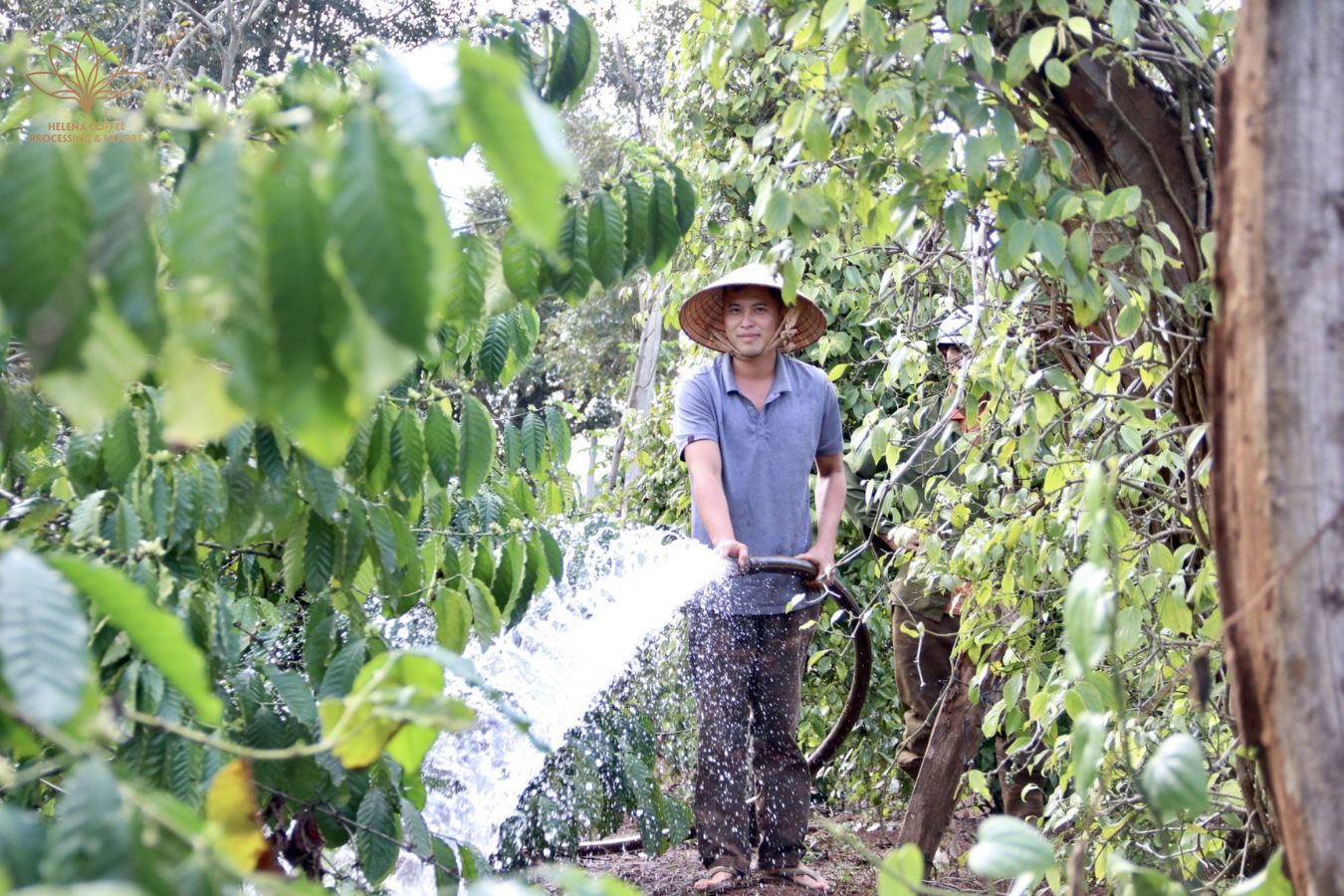
Coffee Farming: Watering Techniques For Coffee Plants – Whole Farming is a particular column from Helena Coffee Vietnam that provides an overview of what you can and can’t control and how to exercise what holds you can create a sustainable crop and a good cup of coffee.
Coffee is a moisture-loving crop that needs a lot of irrigation water to grow and develop well. Meanwhile, in recent years, the area of coffee deprived of irrigation water has been on the rise.
Therefore, using water-saving irrigation systems for coffee in the context of climate change is an inevitable trend.
In this section, we will study the effectiveness of several different tools and techniques that can be used in an area of coffee soup to aid in making practical decisions about when to irrigate and how much water to use.
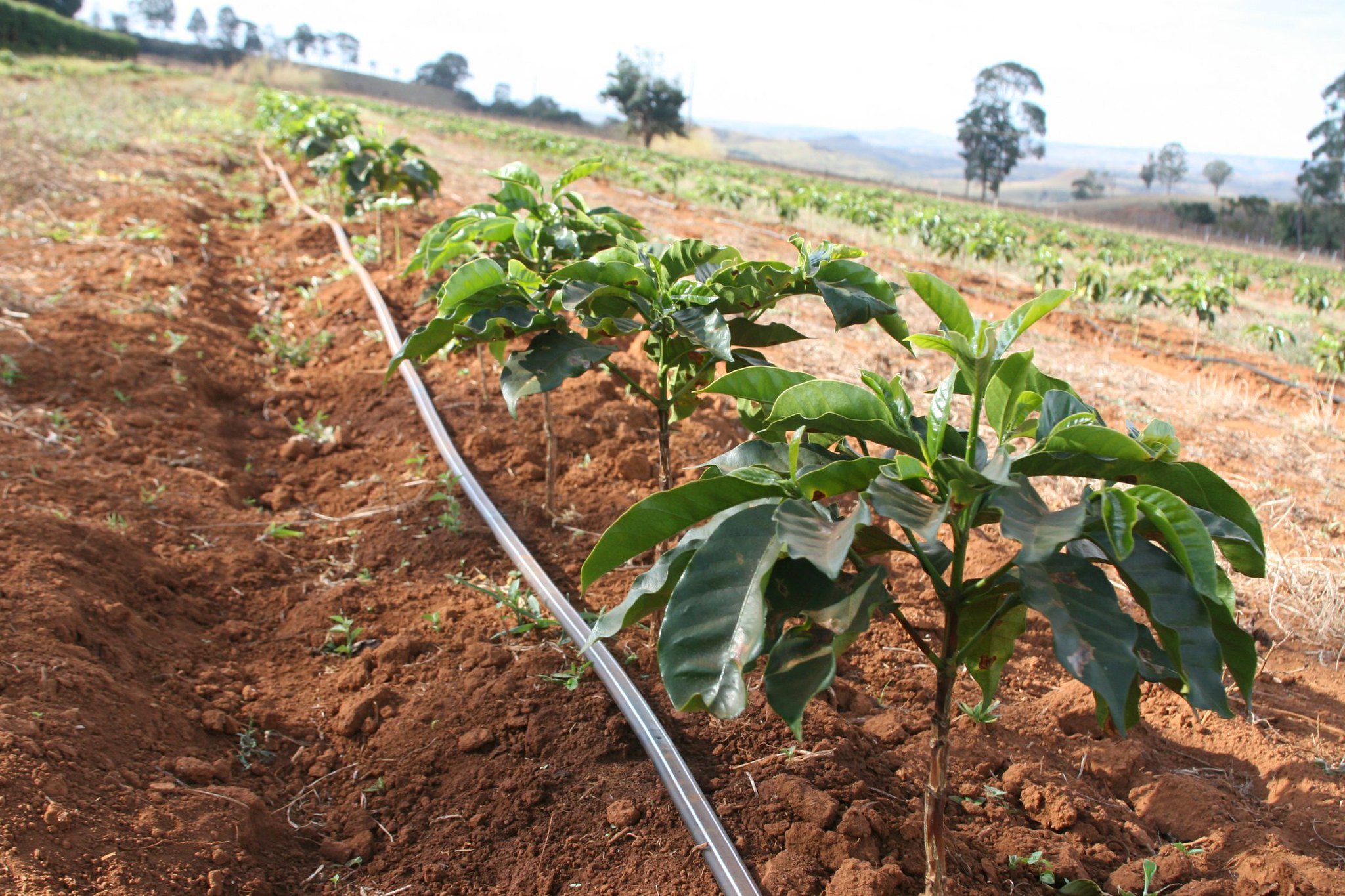
Typically, there is a minimum of 3 to 4 months of dryness in coffee-growing areas. This affects the yield, and untimely and insufficient rainfall leads to abnormal flowering of coffee.
To overcome the adverse effects of drought, irrigation is one of the most critical management methods. Preserving soil moisture and effectively using the soil in the dry period will certainly avoid anomalies in flowers (star-shaped flowers, pink and tapered flowers).
However, untimely and excessive irrigation can also adversely affect yields. Early irrigation (before the buds are full) can lead to abnormalities when the plant flowers and blooms constantly and bears poor fruiting.
Irrigation is expensive, and irrigation water is limited on many farms, so watering plants at the right time based on plant needs is vital in increasing yields (Naidu, 2003).
The scientific basis for watering coffee
Irrigation water management” we will study some other interventions that can help mitigate the effects of drought. In the process of differentiation of flower sprouts, flowering, and fruiting in the dry season, plants need enough water to ensure flower bloom, pollination, and fruiting.
The dry season in the Central Highlands lasts six months, so it is necessary to water the crops.
Each type of soil is different, and the water supply and water needs are also other, so the number of watering and watering cycles are different.
The climatic conditions of each region are different, and the number of watering and irrigation cycles are not the same. The cultivation mode and the number of waterings and watering cycles are also different.
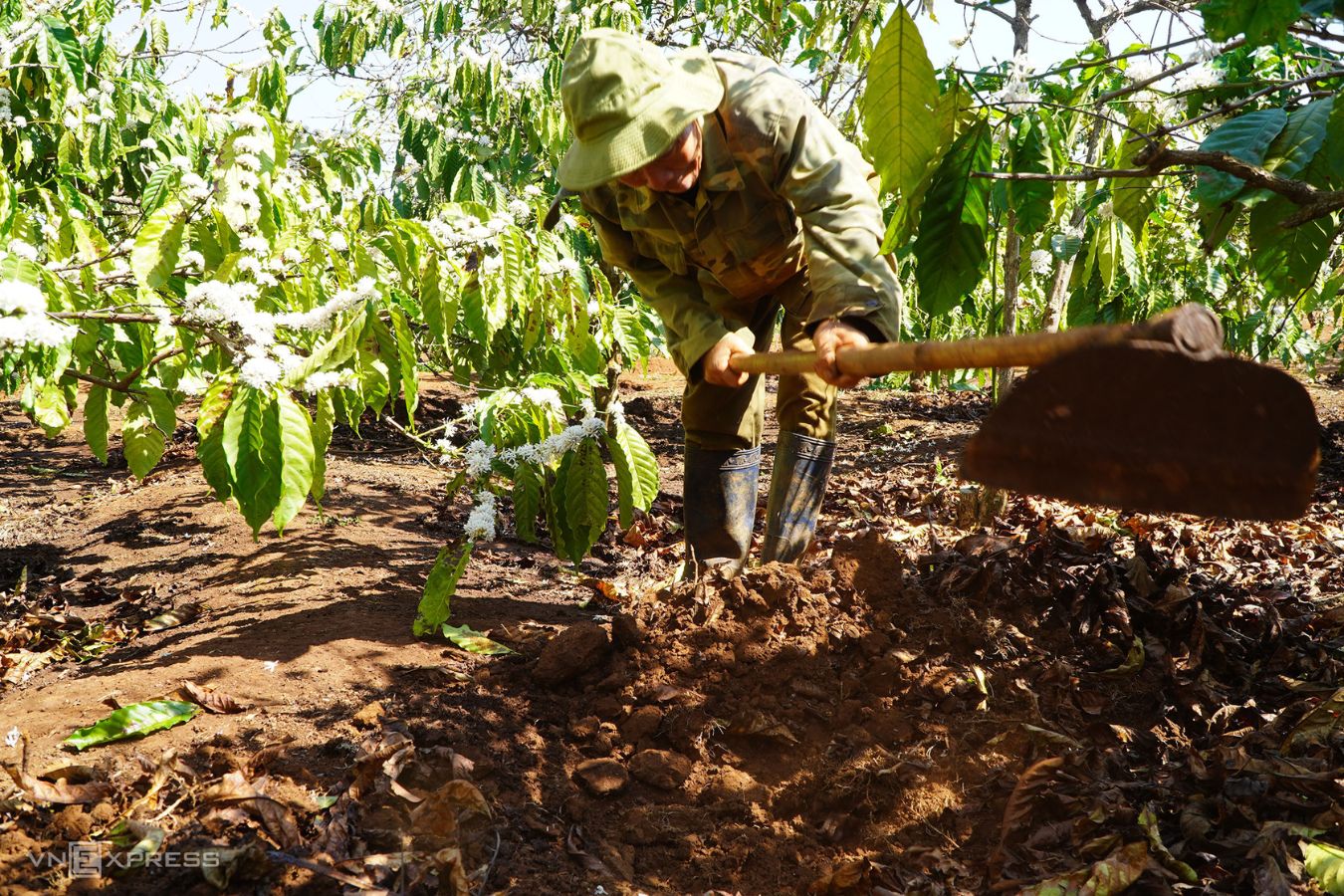
After harvesting, coffee plants need to have a dry period; when the flowers have been differentiated and have reached old age, if watered enough, they will bloom.
For coffee plants, a crop of forced cross-pollination, centralized flowering is critical to pollination and yield formation. Full flowering is a favorable condition for pollination.
In addition to the indicators of blooming and yield, the hands of the growing situation are also of interest to many producers.
Coffee gardens through the dry season that are watered well will show good greenery and vice versa. If there is no water, the coffee garden will become yellow.
Abundant irrigation does not increase productivity but increases costs, wasting water resources. Over-watering can also adversely affect productivity.
Early irrigation (before the buds are full) can lead to abnormalities when the plant flowers and blooms constantly and bears poor fruiting. Irrigation lacks water, the plant does not bloom, the flowers are shrunk, the branches are dry, the leaves fall off, and growth is affected.
Watering technique
To fully establish coffee plantations at the mechanical construction stage, coffee needs to be rinsed during the dry season to the proper depth below the root zone, and the distance between waterings should be long enough to ensure dry soil avoidance of waterlogging.
This allows the roots to grow deep to protect themselves against drought and improve the plant’s firmness.
In Vietnam, Robusta coffee plants are more drought-resistant, responding better to watering than tea coffee. First, irrigation in the dry season needs to be carried out after 20-25 days from stopping rain.
The recommended amount of irrigation is 20 – 25 days one time, with irrigation of 25 mm until the end of December.
The final watering for bloom is 12-25 mm throughout the second half of February, and then the amount of irrigation decreases, and the interval between waterings is 38-2 days after blooming (BMT Coffee Association, 15)
Rain-spray irrigation technique
The irrigation system consists of pumps with a capacity of 15-50 horsepower and a light metal duct system, usually made of aluminum alloy for easy movement by manual and, finally, nozzles.
Under pressure in the duct system, water particles exit the nozzle as tiny raindrops; irrigation water is evenly distributed throughout the canopy.

The rain spray irrigation technique is most widely used in coffee-growing countries thanks to the high water quality; the irrigation system can generally work in places with complex terrain with many steep hills; the number of watering is low, on average watering three times a year.
India’s review shows that applying rain irrigation techniques has improved tree nutrient conditions, resulting in concentrated fruit ripening, branch length doubling, and yields increasing by 85-95% compared to unwatered gardens (Naidu, 2000).
Shaping coffee gardens for rain irrigation: This is essential to achieve maximum response to irrigation. Old and dense coffee under thick shade conditions should not use rain irrigation.
Preference should be given to silk coffee and coffee that responds well. Shade trees must be well controlled, and coffee must be cut regularly after harvest.
Toothpicks, dead branches, and chiseled branches by weevils must be cut off. It is also necessary to control the growth of weeds.
| Plant type | Rain spray irrigation (m3/ha/time) | Irrigation cycle (days) |
| Basic construction period | 400 – 500 | 25 – 30 |
| King’s Period | 500 – 600 | 30 – 35 |
The main obstacle of this irrigation technique is that it consumes a lot of energy due to the high pressure requirements at the nozzle, water losses are quite high especially when there are high winds. The rate of application of rain spray irrigation for coffee is about 25% lower than root irrigation. – Dinh Thi Nha Truc et al., 2017
Root irrigation techniques
The irrigation system consists of an engine with 8-16 horsepower capacity, a pump, and a plastic plumbing system. Water is directed directly into each earthen tub dug around each coffee tree.
Original irrigation has inexpensive equipment, little water loss, and low fuel cost. The irrigation system is installed and dismantled according to each irrigation, so it is easy to protect and suitable for the conditions of households and dispersed production of Vietnam.

This irrigation technique must create a tub around the root to store irrigation water. When watering, takes the hose and direct the hose to the coffee tub.
The main disadvantages of this irrigation technique are high operating labor costs, heavy operation, and the need to create water tanks around the root; the amount of water irrigated into each seed is uneven, which can be wasteful.
Many countries do not use the original irrigation method because they do not create tanks to store irrigation water.
With the sound planting technique when planting new, the root neck of seedlings is placed 10-15 cm below the surrounding ground, coffee growers in Vietnam have limited the damage of the root system when digging the tub and allowed the effective use of root irrigation techniques. Applying irrigation techniques to coffee accounts for a large proportion in the Central Highlands with about 73%. – ThiNha Truc et al., 2017
Drip irrigation technique
The irrigation system consists of pumps, cleaners, plumbing pipes permanently installed in the orchard, drip hoses, and water distribution valves.
The water supplied is concentrated in the central active part of the plant root system, with a minimal flow, so water and fertilizer efficiency is very high.
Some coffee-growing regions in Brazil, Ivory Coast, and India have used this irrigation technique (Azizuddin, 1994).
The drip irrigation technique has many advantages, such as water saving (30-50%). Snoeck’s (1988) study in Ivory Coast showed that drip irrigation could save 50% of irrigation compared to rain spray irrigation, while coffee yield (accumulated two years) has no difference between the two irrigation methods.

However, drip irrigation has such limitations:
- Expensive equipment; requires high quality of irrigation water; short irrigation cycle (1-10 days); The irrigation system is permanently located on the orchard
- Prolonged irrigation time due to low water output
- Irrigation systems are easily damaged during cultivation (weeding, raking tanks, root cabinets) due to physical impacts
- Failure to produce the necessary air humidity when plants flower and pollinate
- The rotation time between irrigation rigs is quite long, so competing with other irrigation techniques in areas with no abundant water source will be challenging.
- Due to the characteristics of use for crops in Israel with a fixed drip head distance of 40 cm, drip lines are arranged along the coffee rows when installing this system for coffee plants in Vietnam. Hence, some drip heads are not in the coffee tub, causing water waste and, at the same time, creating conditions for weeds. develop
- Drip pipes buried 20-30 cm deep over about 2-3 years these irrigation pipes will be crushed, impeding the flow.
In coffee production in Vietnam, drip irrigation techniques have not been widely applied due to the characteristics of production scale (small area, fragmented …), limited to the scope of research and testing.
Rain-spraying irrigation technique at the root
Based on drip irrigation improvements, rain spray irrigation at the root does not use drip irrigation hoses to increase the flow of irrigation water at each hose to meet the water requirements of plants that need a relatively large amount of irrigation water to bloom.
The irrigation system installed valves to regulate the pressure and flow of irrigation water. The water supplied is concentrated in the central active part of the plant root system, thus improving efficiency and saving water.
In Gia Lai, the 8-15-year-old model of applying rain irrigation at the root combined with water fertilization showed that, on average, in 2 years (2012, 2013) the productivity of the models improved compared to the control, the model in Chu Păh had an outstanding yield compared to the control with a technical efficiency of > 25%. The economic efficiency of the models increased by an average of 11.7 – 17.9%. – Le Ngoc Treasure, 2013
Irrigation techniques at the root to save water for coffee plants are being tested and evaluated on a large scale in production and have many prospects for future development to meet the requirements of water protecting and responding to ongoing climate change.
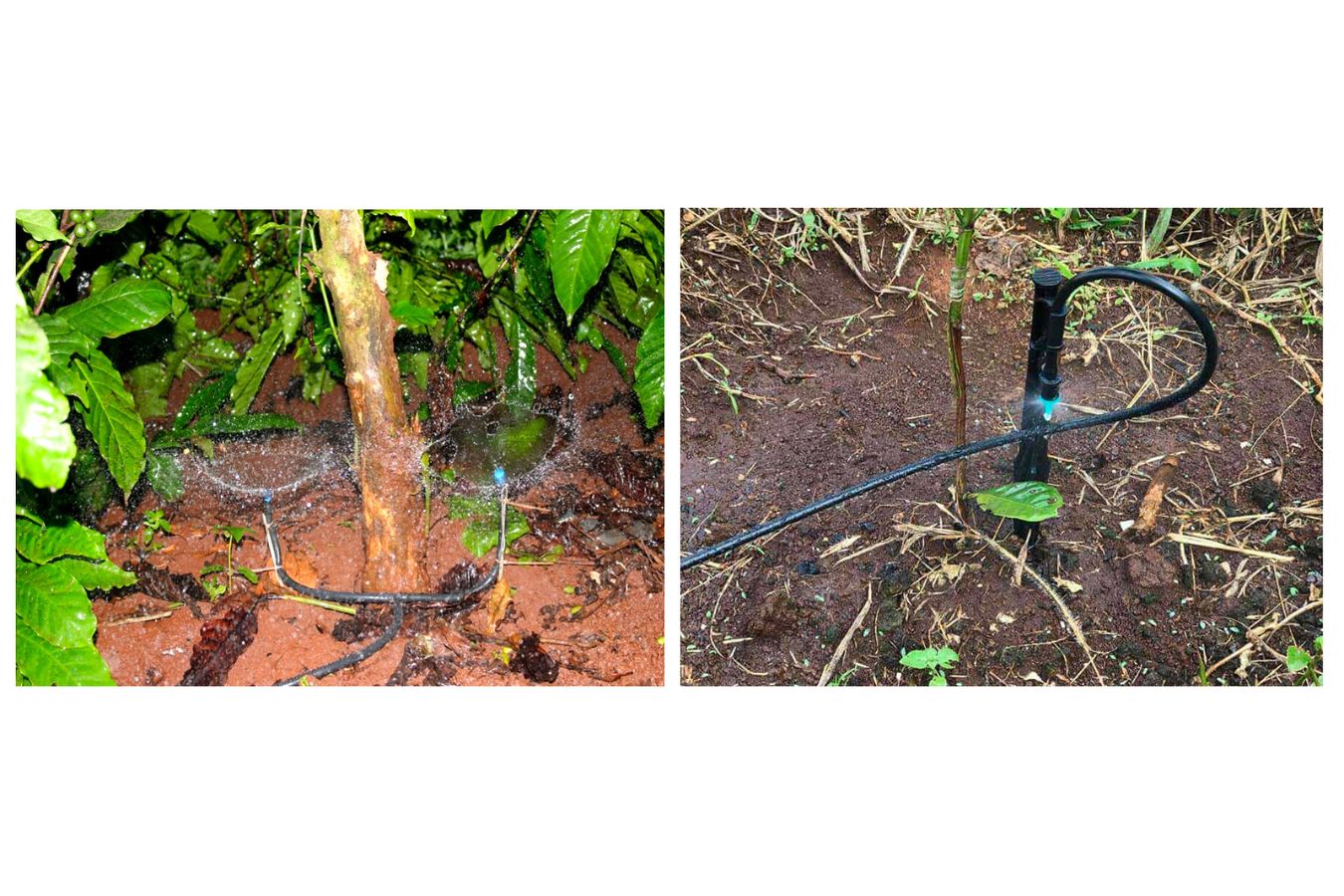
Advantages of rain spray irrigation at the root: water saving, irrigation focusing on the root area, easy installation construction, low installation costs, fertilization through the irrigation system to help improve the efficiency of fertilizer use, saving labor for irrigation and fertilization activities (70-80% reduction compared to traditional irrigation), reduce 20-30% of irrigation water compared to conventional irrigation (Le Ngoc Treasure, 2013); materials are readily available and easy to find; simple operation, does not require much engineering; use many different water sources (ponds, lakes, rivers, streams, dug wells …); lower investment costs than other savings systems; create the necessary microclimate during the flowering phase of coffee; depreciation used for each year is as low as about 5 million / ha/year.
Disadvantages of rain spray irrigation at the root: 1-time total investment cost; perishable during cultivation (weeding, raking of sinks, root cabinets); prone to the local shutdown of irrigation terminals due to the small size of the water output; flat to shafts (turning off water on the irrigation rig) when there is no inlet water filter; resistance to low water pressure; incurring annual remediation costs.
Time to irrigate coffee plants
Determining the timing of the first irrigation when the buds have fully differentiated will contribute to the coffee plant’s concentrated bloom.
When the flower sprouts fully develop on the outermost vertebrae of the branches, about 1.5 cm long, are ivory white, and the leaves have begun to wilt during the day, it is time to water.
Usually, the humidity to be irrigated is higher than wilted plants’ moisture. The humidity to be washed at the 0 – 30 cm floor is chosen for basalt soils to be about 27%.
- Not watering early when the buds are not fully differentiated will cause the flowers to bloom unfocused and the fruits to ripen scattered, increasing costs and wasting water resources. However, when the plant has symptoms of temporary wilting, drooping leaves during the day, and soil moisture below 27%, the flower buds have not fully differentiated; they must still be watered so that the coffee plant is not damaged.
- Late irrigation of plants is depleted, deciduous, dried branches, flowers are shrunk, bloom poorly, and flowers suffer from low yield “lemon blossoms,” affecting the growth and development of plants.
The required amount of irrigation water
WASI’s survey results show that, on average, nearly 60% of coffee producers rinse 3-4 times / dry season with water from 400 to 600 liters/plant/watering; this is a relatively reasonable amount of water for coffee plants to grow and develop normally.
But compared to the current recommendation of WASI, among them, > 50% of households irrigate > 520 liters/plant/time, and up to 23.2% of coffee producers overwater (600 – 950 liters/plant/watering).
If you think watering > 520 liters/plant/time is redundant compared to the recommended, > 73% of farmers over-water coffee, which will cause a waste of water and increase production costs.
This is the scientific and practical basis for recommending reasonable adjustments of irrigation water to reduce costs. Calculations show that farmers’ watering costs are now about 32% higher than recommended (engine irrigation, fueled by diesel).
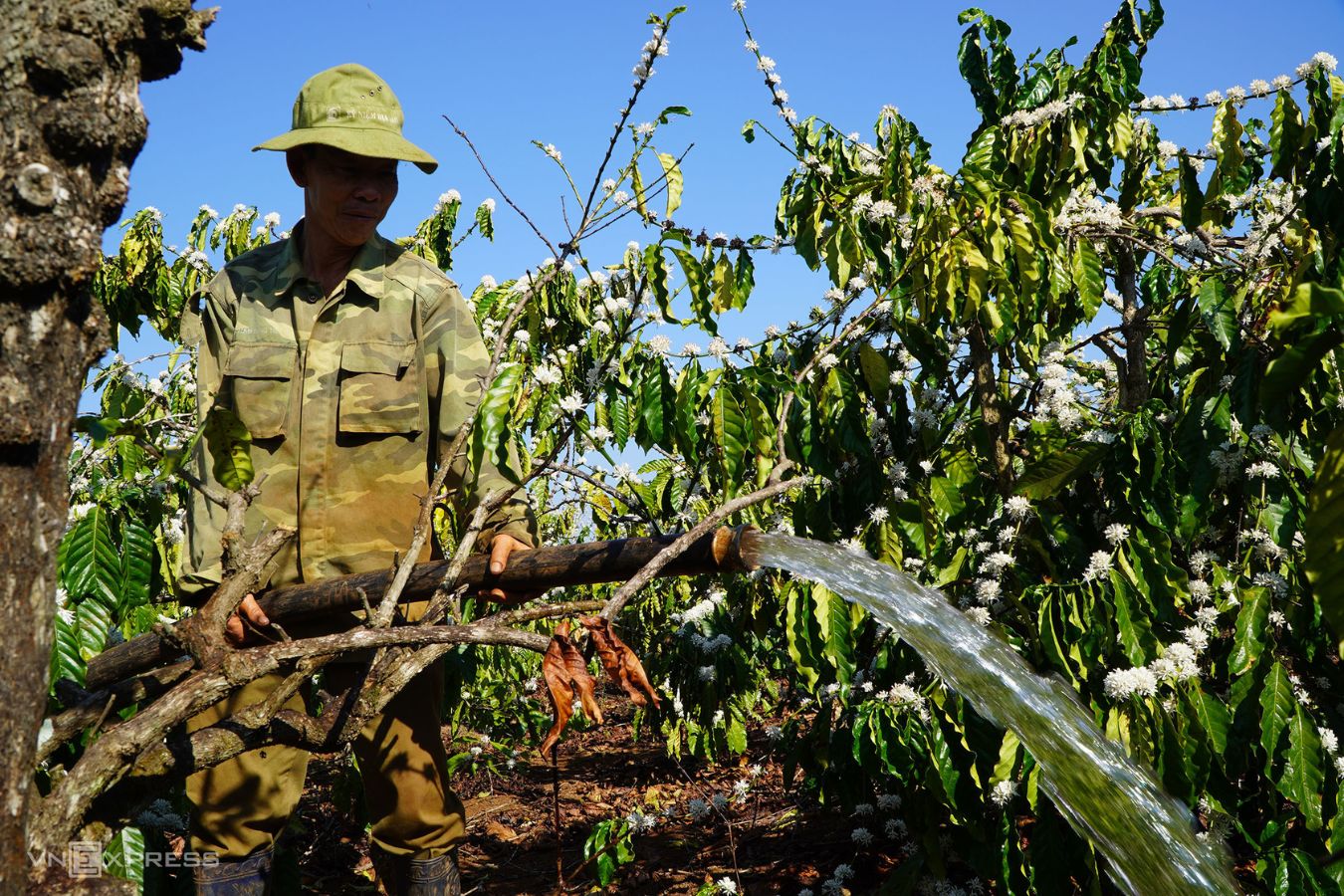
The amount of irrigation water is sufficient to meet the needs of flowering, fruiting and withstand dry conditions, neither excess nor shortage. Sufficient irrigation contributes to reducing costs and protecting the ecological environment. Based on the distribution of the root system of coffee plants, the distribution is mainly on the floor of 0 – 30 cm. So just watering the maximum depth of 30-35 cm is suitable. – BMT Coffee Association, 2021
In short, the amount of irrigation water significantly affects the growth and development of coffee plants.
Depending on soil conditions, the climate determines the right amount of irrigation water; gray soils irrigate less water, irrigation cycles are also shorter, basalt soils flush more water, and irrigation cycles last longer than gray soils.
The amount of irrigation water depends on the weather developments of the year, such as rain ending early or late or rain coming early or late…
The amount of irrigation water from 400 to 500 liters/root and the irrigation cycle from 30 to 35 days will ensure full flowering and good pollination.
References:
- Primecoffea, Canh tác 08: Kỹ thuật tưới nước cho cây cà phê, Tháng Một 19, 2023.